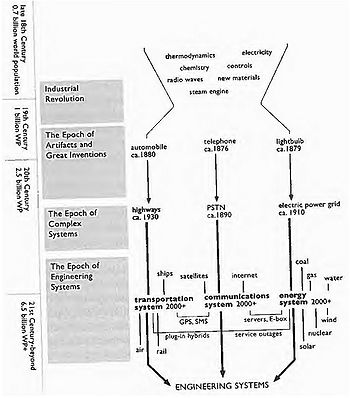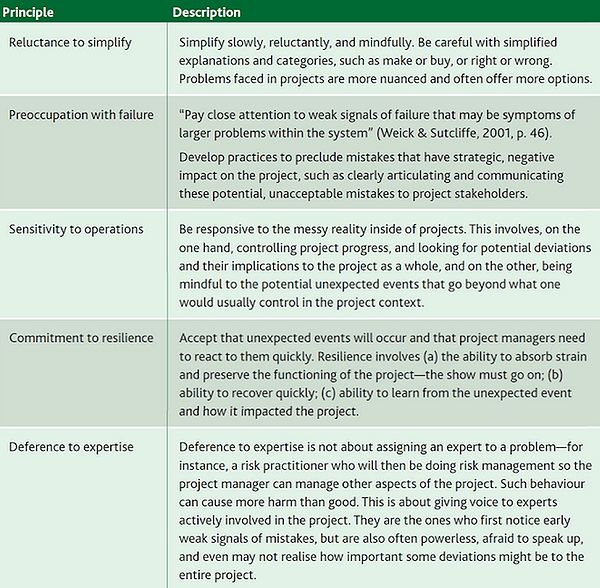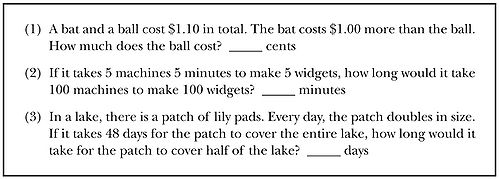Mindfulness and Cognitive Biases in Project Management
MistaJacob (Talk | contribs) |
MistaJacob (Talk | contribs) |
||
| Line 33: | Line 33: | ||
= The Cognitive Reflection Test (CRT) = | = The Cognitive Reflection Test (CRT) = | ||
Before reading on… answer the 3 questions...etc. | Before reading on… answer the 3 questions...etc. | ||
| − | |||
| − | = Conclusion= | + | [[File:CRT.jpg|500px|]] |
| + | |||
| + | = The two ways of thinking = | ||
| + | *Introduce system 1 and 2 the same way it is done in the book. By showing a picture for system 1 and with a math problem for system 2. | ||
| + | **short definitions on 20 bottom-21 top | ||
| + | **elaborate with examples of what system 1 and 2 does | ||
| + | ***list of examples: page 21 for system 1 and 22 for system 2 | ||
| + | *Draw reference to that system 1 is an innate skill shared with other animals. born to perceive the world around us - page 21 bottom | ||
| + | *describe the interaction between system 1 and 2 | ||
| + | **good description on page 24-25 in “Plot Synopsis” | ||
| + | ***1 is involuntary and automatic with no or little effort. | ||
| + | ***2 requires effort and is normally in a comfortable low-effort mode | ||
| + | ***etc. | ||
| + | ***division of labour | ||
| + | **“The often-used phrase “pay attention” is apt: you dispose of a limited budget of attention that you can allocate to activities, and if you try to go beyond your budget, you will fail.” - page 23 middle | ||
| + | **follow with: example with the gorilla - side 23(nederst)-24. | ||
| + | ***Illustrates two important facts about our minds: we can be blind to the obvious, and we are also blind to our blindness. | ||
| + | |||
| + | == System 1 == | ||
| + | *it has little understanding of logic and statistics | ||
| + | *it cannot be turned off | ||
| + | *gullible and biased to believe and confirm | ||
| + | *generates surprisingly complex patterns of ideas | ||
| + | *generates impressions, feelings, and inclinations; when endorsed by system 2, these become beliefs, attitudes, and intentions | ||
| + | *operates automatically and quickly, with little or no effort, and no sense of voluntary control | ||
| + | *can be programmed by system 2 to mobilize attention when a particular pattern is detected (like the illusion with the arrows) | ||
| + | *creates coherent pattern of activated ideas in associative memory | ||
| + | *distinguishes the surprising from the normal | ||
| + | *infers and invent cause and intentions (like seeing patterns that are not necessarily there) | ||
| + | *neglects ambiguity and suppresses doubt (like the ABC or A13C) | ||
| + | *etc. | ||
| + | *the rest is on page 105, but only include what you talk about, or at least mention with a * which ones the reader can read about in the book themselves. | ||
| + | |||
| + | == System 2 == | ||
| + | *in charge of doubting and unbelieving | ||
| + | *only system 2 can construct thoughts in an orderly series of steps. | ||
| + | *system 2 can take over and overrule the freewheeling impulses of system 1 | ||
| + | **To exert self-control | ||
| + | *has a limited amount of attention to allocate | ||
| + | *is generally lazy - follows the rule of least effort | ||
| + | *etc. | ||
| + | |||
| + | |||
| + | = Conclusion = | ||
= References = | = References = | ||
Revision as of 21:25, 21 September 2015
Before introducing the concept of mindfulness and cognitive biases in relation to project management, a short introduction to complexity and the thinking behind ‘engineering systems’ are necessary, as to explain its relevance and usefulness.
Contents |
Complexity
Even among scientists, there is no unique definition of Complexity (Johnson, 2009). Instead, real-world systems of what scientist believe to be complex, have been used to define complexity in a variety of different ways, according to the respective scientific fields. Here, a system-oriented perspective on complexity is adopted in accordance to the definition in Oehmen et al. (2015), which list the properties of complexity to be:
- Containing multiple parts;
- Possessing a number of connections between the parts;
- Exhibiting dynamic interactions between the parts; and,
- The behaviour produced as a result of those interactions cannot be explained as the simple sum of the parts (emergent behaviour)
In other words, a system contains a number of parts that can be connected in different ways. The parts can vary in type as well as the connections between them can. The number and types of parts and the number and types of the connections between them, determines the complexity of the system. Furthermore, incorporating a dynamic understanding of systems, both the parts and their connections changes over time. The social intricacy of human behaviour are one of the larger reasons for this change. We do not always behave rationally and predictably, as will be further examined below, which increases the complexity of every system where humans are involved.
Engineering systems
The view that our modern lives are governed by engineering systems, articulated by Weck, Roos, and Magee (2011), are adopted to explain why the complexity of the world only goes one way, upwards. In short, they distinguish between three levels of systems; artifact, complex, and engineering. At artifact level we have inventions such as, cars, phones, the light bulb, etc. In itself, they do not offer any real benefits to our lives. To utilize their potential, and to exploit their respective benefits, the right infrastructure has to be present. Following the above example, the needed infrastructure consists of; roads, public switched telephone network (PSTN), and the electrical power grid. This level of interconnectedness are defined as the complex system level. Following the development of the earlier separated transportation, communication, and the energy systems, one sees that everything is getting increasingly interconnected. This is the engineering systems level. See Figure 1 for a visual representation of the above example.
One of the characteristics of our modern society and the engineering systems governing it, is that technology and humans cannot any longer be separated. Engineering systems is per definition socio-technical systems, which as described in the section above, only adds to the complexity. “Without the right tools to analyse and understand them, complex systems become complicated: They confuse us, and we cannot control what happens or understand why” (Oehmen et al., 2015, p. 5). Mindfulness is one of those tools that can be adopted to project management to help decomplicate the complexity.
Mindfulness
The meaning of the word mindfulness is defined as: The quality or state of being conscious or aware of something (http://www.oxforddictionaries.com). Following definition is elaborating further: “a rich awareness of discriminatory detail. By that we mean that when people act, they are aware of context, of ways in which details differ (in other words, they discriminate among details), and of deviations from their expectations” (Weick & Sutcliffe, 2001, p. 32). To translate this into a useful model, Weick & Sutcliffe (2001) developed five principles of mindfulness, that could be used to increase the reliability of organizations. In other words, to enhance both the chance that an organization can prevent possibly disastrous unexpected events, as well as making a rapid recovery if they do happen. These principles are therefore well suited to deal with the intrinsic uncertainty of human behaviour and the complexity it brings to organizations. Oehmen et al. (2015) have adapted the five principles to the field of project management, seen in Table 1.
The principle of sensitivity to operations is chosen for further elaboration. The reason lies in the last part of the description: “being mindful to the potential unexpected events that go beyond what one would usually control in the project context”. The “thing” that goes beyond what one would usually control, is in this context chosen to be our own mind. It is well known that cognitive biases exist, and that the deviousness of the mind can constitute a risk to any project. But how can we discipline our mind to think sharper and clearer? How can we make sure that our rational decisions are in fact rational? And, are some people more predispositioned to get caught by cognitive biases than others? Answering these questions will be the focus of the remainder of the article.
To the reviewer
When i write a raport or article i always This is as far as i have gotten with the finished text. The rest of the article is still in
The Cognitive Reflection Test (CRT)
Before reading on… answer the 3 questions...etc.
The two ways of thinking
- Introduce system 1 and 2 the same way it is done in the book. By showing a picture for system 1 and with a math problem for system 2.
- short definitions on 20 bottom-21 top
- elaborate with examples of what system 1 and 2 does
- list of examples: page 21 for system 1 and 22 for system 2
- Draw reference to that system 1 is an innate skill shared with other animals. born to perceive the world around us - page 21 bottom
- describe the interaction between system 1 and 2
- good description on page 24-25 in “Plot Synopsis”
- 1 is involuntary and automatic with no or little effort.
- 2 requires effort and is normally in a comfortable low-effort mode
- etc.
- division of labour
- “The often-used phrase “pay attention” is apt: you dispose of a limited budget of attention that you can allocate to activities, and if you try to go beyond your budget, you will fail.” - page 23 middle
- follow with: example with the gorilla - side 23(nederst)-24.
- Illustrates two important facts about our minds: we can be blind to the obvious, and we are also blind to our blindness.
- good description on page 24-25 in “Plot Synopsis”
System 1
- it has little understanding of logic and statistics
- it cannot be turned off
- gullible and biased to believe and confirm
- generates surprisingly complex patterns of ideas
- generates impressions, feelings, and inclinations; when endorsed by system 2, these become beliefs, attitudes, and intentions
- operates automatically and quickly, with little or no effort, and no sense of voluntary control
- can be programmed by system 2 to mobilize attention when a particular pattern is detected (like the illusion with the arrows)
- creates coherent pattern of activated ideas in associative memory
- distinguishes the surprising from the normal
- infers and invent cause and intentions (like seeing patterns that are not necessarily there)
- neglects ambiguity and suppresses doubt (like the ABC or A13C)
- etc.
- the rest is on page 105, but only include what you talk about, or at least mention with a * which ones the reader can read about in the book themselves.
System 2
- in charge of doubting and unbelieving
- only system 2 can construct thoughts in an orderly series of steps.
- system 2 can take over and overrule the freewheeling impulses of system 1
- To exert self-control
- has a limited amount of attention to allocate
- is generally lazy - follows the rule of least effort
- etc.


